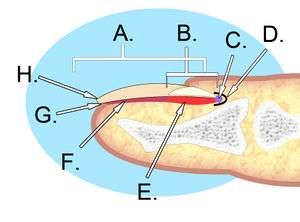Fingertip amputation
Background
- Due to blunt or penetrating trauma
Nailtip Anatomy

A. Nail plate; B. lunula; C. root; D. sinus; E. matrix; F. nail bed; G. hyponychium; H. free margin.
- The perinychium includes the nail, the nailbed, and the surrounding tissue.
- The paronychia is the lateral nail folds
- The hyponychium is the palmar surface skin distal to the nail.
- The lunula is that white semi-moon shaped proximal portion of the nail.
- The sterile matrix is deep to the nail, adheres to it and is distal to the lunule.
- The germinal portion is proximal to the matrix and is responsible for nail growth.
Clinical Features
- Partial or complete amputation of distal phalanx of finger
Differential Diagnosis
Hand and finger injuries
- Distal finger
- Other finger/thumb
- Boutonniere deformity
- Mallet finger
- Jammed finger
- Jersey finger
- Trigger finger
- Ring avulsion injury
- De Quervain tenosynovitis
- Infiltrative tenosynovitis
- Metacarpophalangeal ulnar ligament rupture (Gamekeeper's thumb)
- Hand
- Wrist
- Drummer's wrist
- Ganglion cyst
- Lunotriquetral ligament instability
- Scaphoid fracture
- Extensor digitorum tenosynovitis
- Compressive neuropathy ("bracelet syndrome")
- Intersection syndrome
- Snapping Extensor Carpi Ulnaris
- Vaughn Jackson syndrome
- General
Evaluation
- Xray
Fingertip Zones
- Zone I - Distal to tip of phalanx
- Zone II - Between tip of phalanx and lunula
- Zone III - Proximal to lunula
Management
- Pain control (Digital block)
No exposed bone or nail bed involvement
- Zone I injuries - treat conservatively with serial dressing changes alone
- Cover wound with non-adherent dressing
- Instruct patient to soak fingertip in antibacterial soap-added water for 10min QD and then reapply non-adherent dressing
- Follow up with primary care provider in 2d
- Most will have epithelialization in approximately 1 month[1]
Exposed Bone
- Zone II injuries
- Consider hand surgery consult
- Rongeur bone if bony protuberance
- Trim digital nerves proximal to skin to avoid painful neuroma formation
- Wound closure with flap
- Follow up with hand surgery in 3-5d
- Healing time 3-6wks
- Zone III injuries
- Consult hand surgery if available
- May require distal phalanx amputation
- Consider treating like Zone II
- Healing time 3-6wks[1]
Disposition
- Generally may be discharged
- Hand surgery follow-up (especially if zone II or III injury)
References
- Lamon, RP, et al. Open treatment of fingertip amputations. Ann Emerg Med. 1983; 12(6):358-360.
This article is issued from
Wikem.
The text is licensed under Creative
Commons - Attribution - Sharealike.
Additional terms may apply for the media files.